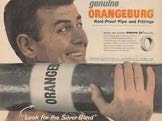 An article published in the November 9th edition of the National Post highlighted the use of cardboard sewer pipes (marketed under the Orangeburg name) in the housing boom after WW II to accommodate the “baby boomers”. This was reflective of the shortage of metal in the late 1940’s and early 1950’s. This article, by Tristin Hopper may be found at the National Post website www.nationalpost.com and searching cardboard pipes. Alternatively Googling “Orangeburg” will indicate a number of sites discussing the problems now being encountered with this piping in many houses. This can be a major expense to the homeowner as they are responsible for the connection from the residence to the City main lines.
An article published in the November 9th edition of the National Post highlighted the use of cardboard sewer pipes (marketed under the Orangeburg name) in the housing boom after WW II to accommodate the “baby boomers”. This was reflective of the shortage of metal in the late 1940’s and early 1950’s. This article, by Tristin Hopper may be found at the National Post website www.nationalpost.com and searching cardboard pipes. Alternatively Googling “Orangeburg” will indicate a number of sites discussing the problems now being encountered with this piping in many houses. This can be a major expense to the homeowner as they are responsible for the connection from the residence to the City main lines.

After reviewing this article we requested from the City a synopsis of the use of this piping in Cambrian Heights. We have published their response below for your information.
“I’ve looked into your request regarding Orangeburg sanitary mains in the Cambrian Heights community. I would like to first point out that the City only keeps database records of the publicly owned portion of each water/sanitary/storm service connection that runs from the mains in the street to the property line of each private home or establishment. The portion of each service connection on private property is generally unknown to us, unless we’ve had a trouble crew investigate a service and they noted the material as part of the investigation.
That being said I can assure you that none of the sanitary mains in the City use this material. We do keep track of the material of each service connection for the city-owned portion of the service. Our records do not track these Orangeburg pipes specifically, although we do have a
material group called “Other” which captures the material of services that are either unknown or not in one of our standard material groups.
Here is the breakdown of sanitary services broken down by material for your community:
The most common sanitary service connection materials used in this community when it was originally developed were Cast Iron and Transite (also known as Asbestos Cement). On the public side of the service, there are only 69 in the community that could potentially be Orangeburg or what we tend to call tar and paper wrapped pipes. Although, I can’t say for sure there are not more or less on the public side of the service connection. In general, the material is likely to be the same on both sides of the service connection, but I can’t say with 100% certainty. I know the tar and paper wrapped pipes exist in other communities because I’ve handled calls about them in the past. The majority of issues with service connections are caused by roots getting into the service, and tend to happen the most with damaged clay tile pipe or these tar/paper wrapped pipes you were asking about.
If you have any further questions, I would be happy to help. Thank you for your 311 service request.
Sincerely,
Jeffrey Hastings, P.Eng.
Infrastructure Engineer, Infrastructure Planning
Water Resources
The City of Calgary | Mail code: #418
T 403.268.1196 | F 403.268.8263 |


Speak Your Mind
You must be logged in to post a comment.